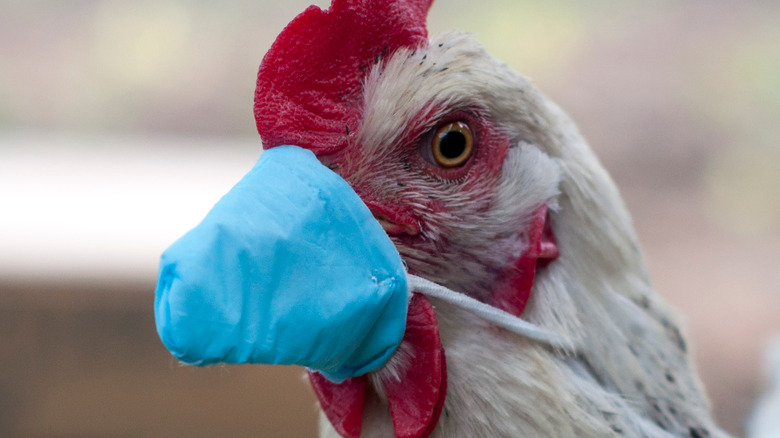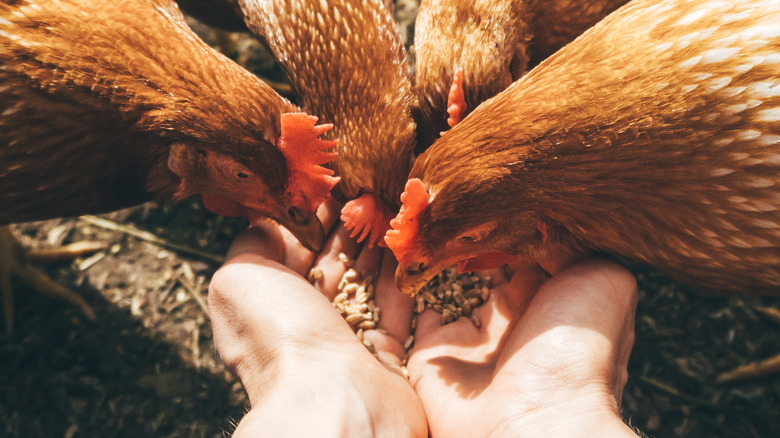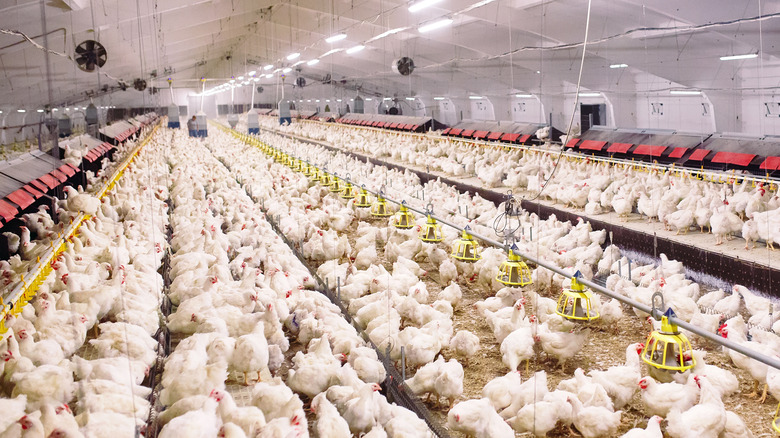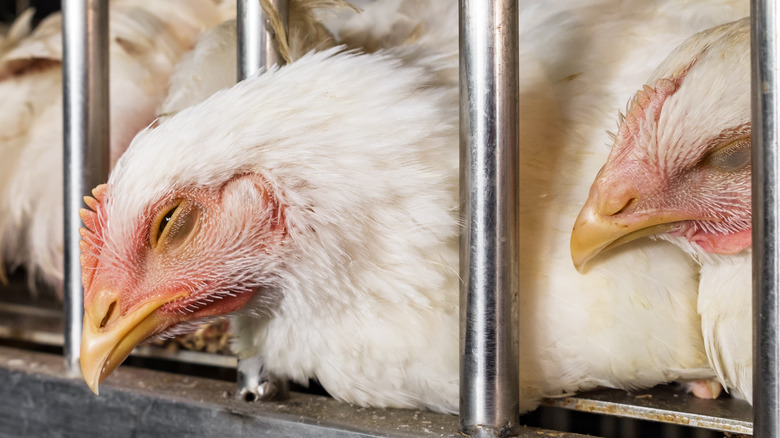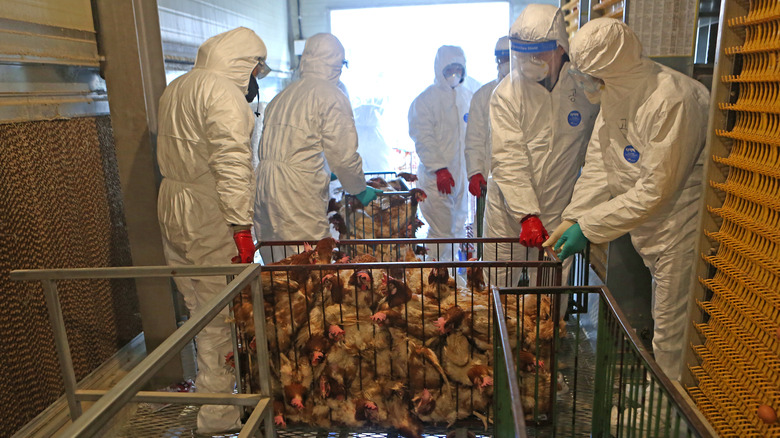The Messed Up History Of The Bird Flu Outbreak Of 2014
In December 2014, the Canadian Food Inspection Agency (CFIA) quarantined two poultry farms in British Columbia. A strain of bird flu was detected among the turkey and chicken populations. As a result, American poultry imports from British Columbia were halted, as they were in countries like South Korea, Japan, Taiwan, and others. That quarantine happened too late. A few weeks later, another bird flu outbreak happened in Oregon. From there, the worst bird flu outbreak in history spread quickly. It would affect not just the multi-billion-dollar poultry industry, but also food prices and food supply worldwide, according to Reuters.
New strains of bird flu continue to spread to this day, even though they're watched closely by government agencies at home and abroad. In 2022, roughly 30 states reported nearly 36 million bird flu cases and counting. More cases are found in wild birds. Although rare, when humans catch bird flu it can be deadly. A look back at the 2014 bird flu outbreak shows that bird flu poses an existential threat to millions of birds both wild and domesticated. It also undermines our own health and safety, food security, and infrastructure (per the Centers for Disease Control and Prevention — CDC).
What is bird flu?
Bird flu, or avian influenza, is one of a number of virus types isolated in wild and domesticated bird populations around the world. Some strains are less lethal than others. Bird flu is common in aquatic birds like ducks, and has also been found in swans, terns, and shorebirds, among other species. Some ducks for example, can carry bird flu and shed the virus but not get sick. When bird flu breaks out in domestic bird populations like chickens and turkeys, it tends to be deadly.
Bird flu is highly contagious across bird species through saliva and other bodily fluids. It can also be caught by birds from unclean surfaces, according to the CDC. Since wild birds migrate, bird flu easily passes from population to population. When outbreaks are detected both in farms and among wild birds, food safety authorities and the poultry industry must act quickly. The consequences of serious or even uncontrolled spread of bird flu could be devastating.
We're not 100% sure how it spreads
Migration aside, there's some mystery to how avian influenza spreads so quickly and to so many places all at once. The infrastructure of the poultry industry is highly interconnected worldwide, and this may offer some explanation. So, too, might spread from farmed poultry to humans on clothing, boots, or even farming equipment, which can then transfer to other farms or to poultry processing centers, as the U.S. Geological Survey (USGS) explains. Air, feed, people, vehicles, birds, and water might all contribute to spread, but much of how bird flu travels across great distances is not well understood, according to Time.
Within a matter of months, bird flu came to America in 2014. Among the worst outbreaks happened in Iowa, home to America's largest egg industry. It affected nearly 5 million egg-laying hens. Shortly thereafter, foreign countries, including both Mexico and Saudi Arabia, halted poultry and egg imports in an effort to keep bird flu outside their borders. In response, the Federal Government approved millions in spending to halt the spread, as Reuters reports.
A state of emergency
Federal funds notwithstanding, several U.S. states declared their own states of emergency in response to the bird flu in 2014, including Wisconsin, Nebraska, Minnesota, and Iowa. As a result, domestic egg production and egg supply in America and overseas dropped precipitously. At the time, bird flu vaccines were still under development. Today, an effective bird flu vaccine for both humans and animals is closer than ever, according to the University of Wisconsin-Madison's School of Veterinary Medicine.
Whether domestic or wild, symptoms of bird flu include lethargy and what's described as "stargazing," as infected birds twist their necks and look towards the sky, according to Time. They may also stop eating and drinking and begin to lay fewer eggs. Infected birds might cough or have diarrhea. Although some wild birds carry bird flu but don't get sick, for chickens and turkeys, there's a 10% chance of survival, at best (via the CDC).
How many birds were culled?
In response to the serious outbreak of bird flu in 2014, many domesticated birds were culled, or killed. Without a vaccine, authorities are left with few other options to address the issue. It's estimated that nearly 50 million turkeys and chickens were destroyed. Quarantined flocks and heavy surveillance can also effectively mitigate avian flu (via the CDC). By June of 2014, bird flu was only detected in wild bird populations and not among domestic birds. The outbreak subsided, according to Reuters. By December, the virus' presence was confirmed in a mixed poultry flock in Douglas County, Oregon. Per Time, some 39 American sites were affected.
Also according to Time, the particular strain of virus behind the 2014 North American spread was of mixed origin, meaning strains that circulated worldwide came to the U.S. and then mixed with wild and domestic bird populations to become something else entirely. That's very similar to what's been seen in the different variants of coronavirus causing the COVID-19 pandemic, per Johns Hopkins Medicine.
Humans rarely catch bird flu
In 2014, the particular strain of avian flu that ravaged the American poultry industry is not known to have spread from birds to humans. However, other variants in parts of the world like Asia, Europe and Africa can pass to humans, according to Time. Therefore, it is possible for humans to catch some strains of bird flu. Mild symptoms include a cough and sore throat, while more serious cases bring on pneumonia and breathing difficulties, per the CDC. Many humans have died. The H5N1 bird flu virus that raised such an alarm in around 2007 killed more than half of those who contracted it, according to Stat News.
When one outbreak of bird flu dies down, such as it did in 2014, it can be sure that another variant is brewing somewhere in the world, waiting to break out just as it has in 2022, per the USDA Animal and Plant Health Inspection Service (APHIS). NPR reports that as of April 23, nearly 23 million birds have died as a result of the present outbreak — some from the virus itself, but many more that were culled to prevent its spread. For this reason, avian flu strains are carefully monitored to tamp down possible variant outbreaks that could disrupt the global poultry industry, or that one day might be more deadly to humans.
